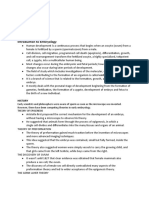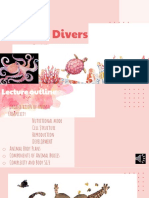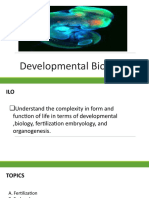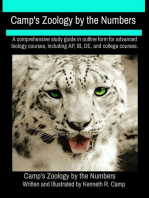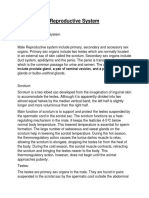Principal Features of Development: 1. Fertilization/ Insemination/pollination/ Fecundation/ Syngamy and Impregnation
Principal Features of Development: 1. Fertilization/ Insemination/pollination/ Fecundation/ Syngamy and Impregnation
Uploaded by
Hashim khanCopyright:
Available Formats
Principal Features of Development: 1. Fertilization/ Insemination/pollination/ Fecundation/ Syngamy and Impregnation
Principal Features of Development: 1. Fertilization/ Insemination/pollination/ Fecundation/ Syngamy and Impregnation
Uploaded by
Hashim khanOriginal Description:
Original Title
Copyright
Available Formats
Share this document
Did you find this document useful?
Is this content inappropriate?
Copyright:
Available Formats
Principal Features of Development: 1. Fertilization/ Insemination/pollination/ Fecundation/ Syngamy and Impregnation
Principal Features of Development: 1. Fertilization/ Insemination/pollination/ Fecundation/ Syngamy and Impregnation
Uploaded by
Hashim khanCopyright:
Available Formats
Developmental Biology 4(3+1)
1. Principal features of development
There are following principal processes in vertebrates.
1. Fertilization
2. Cleavage
3. Gastrulation
4. Organogenesis
5. Metamorphosis
6. Gametogenesis
7. Death
1. Fertilization/ insemination/pollination/ fecundation/ syngamy and impregnation
It is the fusion of haploid gametes, egg and sperm, to form the diploid zygote. The mechanics
behind fertilisation has been studied extensively in sea urchins and mice. There are three steps
to fertilisation that ensure species-specificity:
1. Chemotaxis
2. Sperm activation/acrosomal reaction
3. Sperm/egg adhesion
Acrosome reaction on a sea urchin cell.
Sperm find the eggs via chemotaxis. Chemotaxis is the movement of an organism in response to a
chemical stimulus. After finding the egg, the sperm penetrates the jelly coat through a process
called sperm activation. An oligosaccharide component of the egg binds and activates a receptor
on the sperm and causes the acrosomal reaction. The acrosomal vesicles of the sperm fuse with
Course Instructor: Ghulam Muhayyaodin
Developmental Biology 4(3+1)
the plasma membrane and are released. In this process, molecules bound to the acrosomal vesicle
membrane, such as bindin, are exposed on the surface of the sperm. These contents digest the jelly
coat and eventually the vitelline membrane. In addition to the release of acrosomal vesicles, there
is explosive polymerisation of actin to form a thin spike at the head of the sperm called the
acrosomal process. The sperm binds to the egg through another ligand reaction between receptors
on the vitelline membrane. Fusion of the plasma membranes of the sperm and egg are likely
mediated by bindin. At the site of contact, fusion causes the formation of a fertilisation cone.
Bindin may refer to: A protein involved in the process of sea urchin fertilization, which is a form
of species-specific recognition of the egg by the sperm.
2. Cleavage
In embryology, cleavage is the division of cells in the early embryo. The process follows
fertilization, with the transfer being triggered by the activation of a cyclin-dependent kinase
complex. A cyclin-dependent kinase complex (CDKC, cyclin-CDK) is a protein complex.The
processes of karyokinesis (mitosis) and cytokinesis work together to result in cleavage. The mitotic
apparatus is made up of a central spindle and polar asters made up of polymers of tubulin protein
called microtubules. The asters are nucleated by centrosomes and the centrosomes are organized
by centrioles brought into the egg by the sperm as basal bodies. Cytokinesis is mediated by the
contractile ring made up of polymers of actin protein called microfilaments. Karyokinesis and
cytokinesis are independent but spatially and temporally coordinated processes. While mitosis can
occur in the absence of cytokinesis, cytokinesis requires the mitotic apparatus. The end of cleavage
coincides with the beginning of zygotic transcription.
Course Instructor: Ghulam Muhayyaodin
Developmental Biology 4(3+1)
3. Gastrulation
Gastrulation is a phase early in the embryonic development of most animals, during which
the single-layered blastula is reorganized into a multilayered structure known as the
gastrula. Before gastrulation, the embryo is a continuous epithelial sheet of cells; by the
end of gastrulation, the embryo has begun differentiation to establish distinct cell lineages,
set up the basic axes of the body (e.g. dorsal-ventral, anterior-posterior), and internalized
one or more cell types including the prospective gut.
A morula (Latin, morus: mulberry) is an early-stage embryo consisting of 16 cells (called
blastomeres) in a solid ball contained within the zona pellucida.
The blastula (from Greek βλαστός (blastos), meaning "sprout") is a hollow sphere of cells,
referred to as blastomeres, surrounding an inner fluid-filled cavity called the blastocoele
formed during an early stage of embryonic development in animals. Gastrula is an embryo
at the stage following the blastula, when it is a hollow cup-shaped structure having three
layers of cells. In triploblastic organisms the gastrula is trilaminar ("three-layered"). These
three germ layers are known as the ectoderm, mesoderm, and endoderm. In diploblastic
organisms, such as Cnidaria and Ctenophora, the gastrula has only ectoderm and endoderm.
The two layers are also sometimes referred to as the hypoblast and epiblast. Gastrulation
takes place after cleavage and the formation of the blastula. Gastrulation is followed by
organogenesis, when individual organs develop within the newly formed germ layers.
Course Instructor: Ghulam Muhayyaodin
Developmental Biology 4(3+1)
First stages of division of mammalian embryo. Semidiagrammatic. (From a drawing by
Allen Thomson.) z.p. Zona striata. p.gl. Polar bodies. a. Two-cell stage. b. Four-cell stage.
c. Eight-cell stage. d, e. Morula stage.
4. Organogenesis
Course Instructor: Ghulam Muhayyaodin
Developmental Biology 4(3+1)
Organogenesis is the process by which the three germ tissue layers of the embryo, which
are the ectoderm, endoderm, and mesoderm, develop into the internal organs of the
organism. Organogenesis is the phase of embryonic development that starts at the end of
gastrulation and continues until birth.
5. Metamorphosis
Metamorphosis is a biological process by which an animal physically develops after birth
or hatching, involving abrupt change in the animal's body structure through cell growth
and differentiation. Some insects, fish, amphibians, mollusks, crustaceans, cnidarians,
echinoderms, and tunicates undergo metamorphosis, which is often accompanied by a
change of nutrition source or behavior. Animals can be divided into species that undergo
complete metamorphosis ("holometaboly"), incomplete metamorphosis ("hemimetaboly"),
or no metamorphosis ("ametaboly").
Metamorphosis of butterfly
6. Gametogenesis
Course Instructor: Ghulam Muhayyaodin
Developmental Biology 4(3+1)
It is the process whereby a haploid cell (n) is formed from a diploid cell (2n) through meiosis and
cell differentiation. Gametogenesis in the male is known as spermatogenesis and produces
spermatozoa. Gametogenesis in the female is known as oogenesis and result in the formation of
ova.
7. Death
Death is the cessation of all biological functions that sustain a living organism. Phenomena which
commonly bring about death include aging, predation, malnutrition, disease, suicide, homicide,
starvation, dehydration, and accidents or major trauma resulting in fatal injury. The remains of a
living organism begin to decompose shortly after death.
Course Instructor: Ghulam Muhayyaodin
You might also like
- Zoology 10th Edition Miller Test BankDocument24 pagesZoology 10th Edition Miller Test BankAmberKaneamdq100% (49)
- Temporomandibular Disorders - A Translational Approach From Basic Science To Clinical Applicability PDFDocument218 pagesTemporomandibular Disorders - A Translational Approach From Basic Science To Clinical Applicability PDFRuchira Sawade100% (1)
- Blood Banking Lab Manual 3rdDocument7 pagesBlood Banking Lab Manual 3rdDanna Angelick ReyesNo ratings yet
- Embryology Part 1Document34 pagesEmbryology Part 1Aira CorderoNo ratings yet
- Chapter 33 - Descriptive EmbryologyDocument12 pagesChapter 33 - Descriptive Embryologyngquvu67% (15)
- Arun PPT - PPTX ..HUMAN REPRODUCTION FOR HSC Board Maharashtra State..Document65 pagesArun PPT - PPTX ..HUMAN REPRODUCTION FOR HSC Board Maharashtra State..arunmishra1986100% (1)
- 8000 GK Questions UpdatedDocument260 pages8000 GK Questions UpdatedPrasanna100% (2)
- Bio 152 Lab 10 Animal Developemnt Worksheet PDFDocument18 pagesBio 152 Lab 10 Animal Developemnt Worksheet PDFHyena100% (1)
- Zly 106 Growth and DevelopmentDocument12 pagesZly 106 Growth and DevelopmentOyeleke AbdulmalikNo ratings yet
- Module 5Document10 pagesModule 5Phan MhiveNo ratings yet
- Animal - Development (Kel 1-5)Document83 pagesAnimal - Development (Kel 1-5)MelatiNo ratings yet
- Activity 6 - Animal Development 23Document10 pagesActivity 6 - Animal Development 23Via IsabelNo ratings yet
- 8.introduction To EmbryologyDocument63 pages8.introduction To EmbryologyAhmed OrabyNo ratings yet
- CH 47 - Animal DevelopmentDocument70 pagesCH 47 - Animal DevelopmentSofiaNo ratings yet
- Embryology Kul FKDocument65 pagesEmbryology Kul FKFahreza ArraisyNo ratings yet
- Principles of Development: Developmental BiologyDocument86 pagesPrinciples of Development: Developmental BiologyPaolo OcampoNo ratings yet
- Zly 106 Growth and Development-1Document12 pagesZly 106 Growth and Development-1lordsonezema1No ratings yet
- Lecture Guide: Introduction To EmbryologyDocument23 pagesLecture Guide: Introduction To EmbryologyAldrin Hardy PabloNo ratings yet
- Act06 Animal Development DiscussionDocument5 pagesAct06 Animal Development DiscussionGlaze HernandezNo ratings yet
- Animal Diversity: Zarah Alaska-VillalonDocument68 pagesAnimal Diversity: Zarah Alaska-VillalonGabrielle Salamanca CastuloNo ratings yet
- Development Biology-1Document11 pagesDevelopment Biology-1emmaqwashNo ratings yet
- Introduction & Overview: Developmental BiologyDocument52 pagesIntroduction & Overview: Developmental BiologyArtika Muliany TindaonNo ratings yet
- GASTRULATIONDocument4 pagesGASTRULATIONProjjal SanyalNo ratings yet
- Developmental BiologyDocument22 pagesDevelopmental BiologyLi KimNo ratings yet
- Zo 103Document5 pagesZo 103Ravi ChauhanNo ratings yet
- EmbryologyDocument30 pagesEmbryologyDharaniNo ratings yet
- Review of Fetal DevelopmentDocument71 pagesReview of Fetal DevelopmentlisafelixNo ratings yet
- Human Embryology: Presenting By: Ms.G.Nivedhapriya M, SC ., Nursing Sripms-Con CoimbatoreDocument74 pagesHuman Embryology: Presenting By: Ms.G.Nivedhapriya M, SC ., Nursing Sripms-Con CoimbatoreKavipriyaNo ratings yet
- Human Reproduction-IiDocument11 pagesHuman Reproduction-IiSuryansh SharmaNo ratings yet
- Sofy Permana: Perkembangan Hewan DAN Ciri-Ciri Manusia Berdasarkan UsiaDocument56 pagesSofy Permana: Perkembangan Hewan DAN Ciri-Ciri Manusia Berdasarkan UsiaDhea Rafsaloka UtomoNo ratings yet
- Embryonic Development - WikipediaDocument7 pagesEmbryonic Development - WikipediadearbhupiNo ratings yet
- Reproduction in Organisms Class 12 NotesDocument12 pagesReproduction in Organisms Class 12 NotesShayan SaifiNo ratings yet
- Chapter 38 Animal DevelopmentDocument77 pagesChapter 38 Animal Developmentmaria banunaekNo ratings yet
- EmbryologyDocument9 pagesEmbryologyRuhul Qudus NaimNo ratings yet
- Ladakh PlaceDocument7 pagesLadakh Placethippeshthippesh275No ratings yet
- Animal DevelopmentDocument12 pagesAnimal DevelopmentJobelle CajipoNo ratings yet
- Las 1 Q4Document10 pagesLas 1 Q4triplesevenNo ratings yet
- Physiology of Reproduction (2019) Notes:: Provided by Yvonne HodgsonDocument14 pagesPhysiology of Reproduction (2019) Notes:: Provided by Yvonne HodgsonBảoChâuNo ratings yet
- EmbryologyDocument101 pagesEmbryologytawandarukwavamadisonNo ratings yet
- Army Public School Gopalpur: Class-Xii Science Subject - Biology Chapter-3 Human Reproduction NotesDocument7 pagesArmy Public School Gopalpur: Class-Xii Science Subject - Biology Chapter-3 Human Reproduction NotesAshok KumarNo ratings yet
- Prenatal GrowthDocument56 pagesPrenatal GrowthnavjotsinghjassalNo ratings yet
- CH 9 ScienceDocument6 pagesCH 9 ScienceRanjana DwivediNo ratings yet
- Developmental Biology: Sengamala Thayaar Educational Trust Women's CollegeDocument35 pagesDevelopmental Biology: Sengamala Thayaar Educational Trust Women's CollegeApratim SinghNo ratings yet
- Unit 13 Beginning of NEW: StructureDocument27 pagesUnit 13 Beginning of NEW: Structurekaladhar reddyNo ratings yet
- General Features of Chordate DevelopmentDocument66 pagesGeneral Features of Chordate DevelopmentJang WonyoungNo ratings yet
- OogenesisDocument10 pagesOogenesisOm Prakash SinghNo ratings yet
- Open Book Exam Muzzammil HussainDocument22 pagesOpen Book Exam Muzzammil HussainRIFAT RAKIBUL HASANNo ratings yet
- Biologija, Embrionalno RazvićeDocument4 pagesBiologija, Embrionalno RazvićeogiNo ratings yet
- NOTES FOR STUDENTS - Sub-Strand-Human Reproductive System-1Document9 pagesNOTES FOR STUDENTS - Sub-Strand-Human Reproductive System-1j2041304No ratings yet
- Cloning of CELLDocument43 pagesCloning of CELLsashaikh1213No ratings yet
- BlastulaDocument4 pagesBlastulaCyanDesNo ratings yet
- Class 12 Biology Zoology em Study Materials 2022-2023 - P.senguttuvan C.valarmathiDocument64 pagesClass 12 Biology Zoology em Study Materials 2022-2023 - P.senguttuvan C.valarmathiartravels1955No ratings yet
- Human Embryonic DevelopmentDocument8 pagesHuman Embryonic DevelopmentGargi BhattacharyaNo ratings yet
- ZOO501-Developmental-Biology Solved Questions FINAL TERM (PAST PAPERS)Document18 pagesZOO501-Developmental-Biology Solved Questions FINAL TERM (PAST PAPERS)Awais BhuttaNo ratings yet
- Definition of TermsDocument6 pagesDefinition of TermsGerald TorresNo ratings yet
- Embryolo GY: Presented By: Ms. Sweta K. Gaude M.Sc. (N) 1 Year SDM InsDocument31 pagesEmbryolo GY: Presented By: Ms. Sweta K. Gaude M.Sc. (N) 1 Year SDM InsSavita HanamsagarNo ratings yet
- +2 Bio Zoo em 1 6 LessonsDocument34 pages+2 Bio Zoo em 1 6 LessonsMohamed AzeemNo ratings yet
- PRINT, I EmbryologyDocument261 pagesPRINT, I EmbryologychpallikarasNo ratings yet
- Lecture1 DescriptiveEmbryology PDFDocument18 pagesLecture1 DescriptiveEmbryology PDFideapadNo ratings yet
- +2 Bio Zoo em 1 6Document34 pages+2 Bio Zoo em 1 6lieb.bhavaNo ratings yet
- GametogenesisDocument8 pagesGametogenesisSOPHIA ALESNANo ratings yet
- Reproduction in AnimalsDocument10 pagesReproduction in AnimalsJewel SajiNo ratings yet
- Pdf&rendition 1Document29 pagesPdf&rendition 1saravanan.kavinilaNo ratings yet
- Camp's Zoology by the Numbers: A comprehensive study guide in outline form for advanced biology courses, including AP, IB, DE, and college courses.From EverandCamp's Zoology by the Numbers: A comprehensive study guide in outline form for advanced biology courses, including AP, IB, DE, and college courses.No ratings yet
- YP 1951 July TricepsDocument4 pagesYP 1951 July TricepsʜзʀᴄᴜʟᴇѕNo ratings yet
- Chap 12Document86 pagesChap 12chemptnkNo ratings yet
- Topic: Mechanisms of Fertilization:: Presented byDocument16 pagesTopic: Mechanisms of Fertilization:: Presented byMajani RajbonshiNo ratings yet
- Muscular SystemDocument3 pagesMuscular SystemJanica Pauline DaydayNo ratings yet
- Facial Cupping Gua Sha InstructionsDocument12 pagesFacial Cupping Gua Sha InstructionsJonathan LópezNo ratings yet
- Histologi Ginjal, Ureter, VU, UretraDocument10 pagesHistologi Ginjal, Ureter, VU, UretraMohammad Hamim SultoniNo ratings yet
- ITQR14Document6 pagesITQR14Vasu NallaluthanNo ratings yet
- C1-Human HeartDocument3 pagesC1-Human HeartNursuzela Abd MalekNo ratings yet
- General Biology 2: 2 Quarter - Module 2Document2 pagesGeneral Biology 2: 2 Quarter - Module 2Veronica RojasNo ratings yet
- A. Pathway: (Lutfi, 2007 Smeltzer, 2000: 360)Document1 pageA. Pathway: (Lutfi, 2007 Smeltzer, 2000: 360)Yosef HidayatNo ratings yet
- Z-03 Digest Part EVDocument50 pagesZ-03 Digest Part EVXaveer AzadNo ratings yet
- Brunnstrom ApproachDocument32 pagesBrunnstrom ApproachTalha ParkarNo ratings yet
- Anaphy Ses 1Document2 pagesAnaphy Ses 1Krisha Mae PascuaNo ratings yet
- ICSE Class 10 Circulatory System NotesDocument4 pagesICSE Class 10 Circulatory System NotesYash Gupta100% (1)
- List of Surgical ProceduresDocument6 pagesList of Surgical ProceduresMatin Ahmad KhanNo ratings yet
- Grade 6 Answer Key Blood and Circulation - Worksheet 2024 NIMRA ZAIDocument4 pagesGrade 6 Answer Key Blood and Circulation - Worksheet 2024 NIMRA ZAIhaniyashaukat14No ratings yet
- Cecilia Case Study 1 4Document2 pagesCecilia Case Study 1 4Tugs KNo ratings yet
- Structure of Human BodyDocument19 pagesStructure of Human BodyWimrod CanenciaNo ratings yet
- A&P Study Guide - Digestive SystemDocument2 pagesA&P Study Guide - Digestive SystemMuhammad FirdausNo ratings yet
- Human Anatomy & PhysiologyDocument72 pagesHuman Anatomy & PhysiologyJoie UrsalNo ratings yet
- Tongue and Its Role in Pros Tho Don TicsDocument100 pagesTongue and Its Role in Pros Tho Don TicsDr Mohit Dhawan100% (19)
- Artificial Hybridisation MCQDocument6 pagesArtificial Hybridisation MCQKartik Gaming 2.0No ratings yet
- Human Body (A Metaphor For An Organization)Document1 pageHuman Body (A Metaphor For An Organization)Jan Patrick ArrietaNo ratings yet
- Reproductive SystemDocument7 pagesReproductive SystemRiaz siddiquiNo ratings yet
- Touch Receptors of The SkinDocument3 pagesTouch Receptors of The SkinMichael Timson33% (3)
- Test Bank For Anatomy and Physiology 2nd Edition by Martini DownloadDocument42 pagesTest Bank For Anatomy and Physiology 2nd Edition by Martini DownloadJacobScottnwgp100% (46)

















